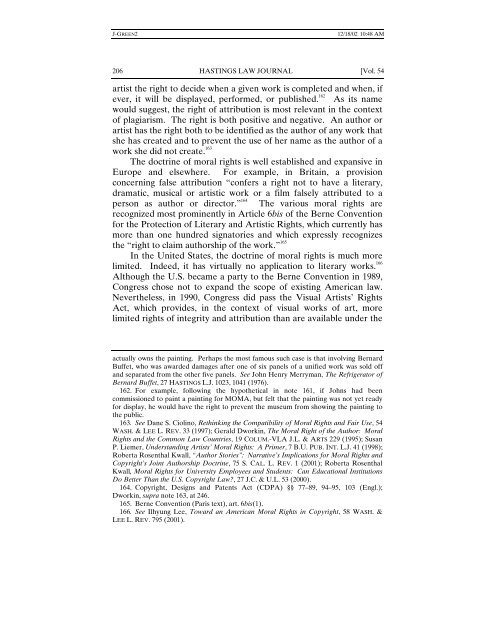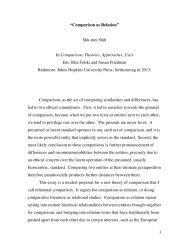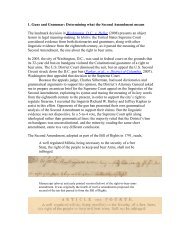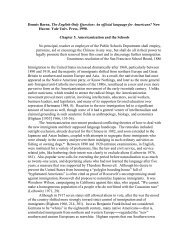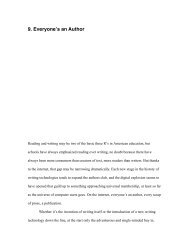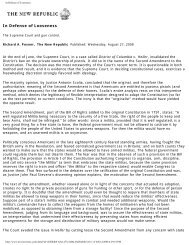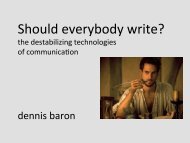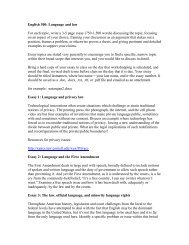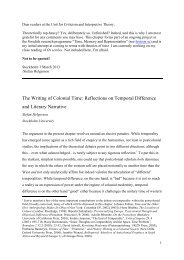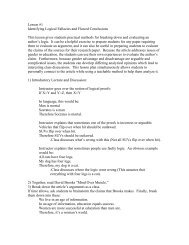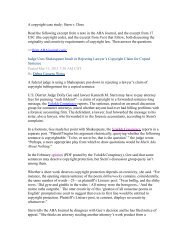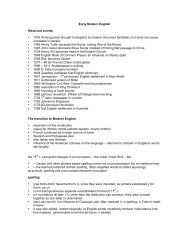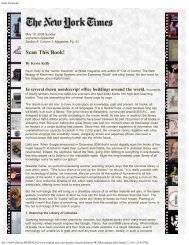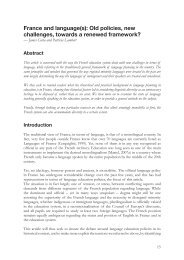Plagiarism, Norms, and the Limits of Theft Law: Some ... - English
Plagiarism, Norms, and the Limits of Theft Law: Some ... - English
Plagiarism, Norms, and the Limits of Theft Law: Some ... - English
Create successful ePaper yourself
Turn your PDF publications into a flip-book with our unique Google optimized e-Paper software.
J-GREEN2 12/18/02 10:48 AM<br />
206 HASTINGS LAW JOURNAL [Vol. 54<br />
artist <strong>the</strong> right to decide when a given work is completed <strong>and</strong> when, if<br />
ever, it will be displayed, performed, or published. 162 As its name<br />
would suggest, <strong>the</strong> right <strong>of</strong> attribution is most relevant in <strong>the</strong> context<br />
<strong>of</strong> plagiarism. The right is both positive <strong>and</strong> negative. An author or<br />
artist has <strong>the</strong> right both to be identified as <strong>the</strong> author <strong>of</strong> any work that<br />
she has created <strong>and</strong> to prevent <strong>the</strong> use <strong>of</strong> her name as <strong>the</strong> author <strong>of</strong> a<br />
work she did not create. 163<br />
The doctrine <strong>of</strong> moral rights is well established <strong>and</strong> expansive in<br />
Europe <strong>and</strong> elsewhere. For example, in Britain, a provision<br />
concerning false attribution “confers a right not to have a literary,<br />
dramatic, musical or artistic work or a film falsely attributed to a<br />
person as author or director.” 164 The various moral rights are<br />
recognized most prominently in Article 6bis <strong>of</strong> <strong>the</strong> Berne Convention<br />
for <strong>the</strong> Protection <strong>of</strong> Literary <strong>and</strong> Artistic Rights, which currently has<br />
more than one hundred signatories <strong>and</strong> which expressly recognizes<br />
<strong>the</strong> “right to claim authorship <strong>of</strong> <strong>the</strong> work.” 165<br />
In <strong>the</strong> United States, <strong>the</strong> doctrine <strong>of</strong> moral rights is much more<br />
limited. Indeed, it has virtually no application to literary works. 166<br />
Although <strong>the</strong> U.S. became a party to <strong>the</strong> Berne Convention in 1989,<br />
Congress chose not to exp<strong>and</strong> <strong>the</strong> scope <strong>of</strong> existing American law.<br />
Never<strong>the</strong>less, in 1990, Congress did pass <strong>the</strong> Visual Artists’ Rights<br />
Act, which provides, in <strong>the</strong> context <strong>of</strong> visual works <strong>of</strong> art, more<br />
limited rights <strong>of</strong> integrity <strong>and</strong> attribution than are available under <strong>the</strong><br />
actually owns <strong>the</strong> painting. Perhaps <strong>the</strong> most famous such case is that involving Bernard<br />
Buffet, who was awarded damages after one <strong>of</strong> six panels <strong>of</strong> a unified work was sold <strong>of</strong>f<br />
<strong>and</strong> separated from <strong>the</strong> o<strong>the</strong>r five panels. See John Henry Merryman, The Refrigerator <strong>of</strong><br />
Bernard Buffet, 27 HASTINGS L.J. 1023, 1041 (1976).<br />
162. For example, following <strong>the</strong> hypo<strong>the</strong>tical in note 161, if Johns had been<br />
commissioned to paint a painting for MOMA, but felt that <strong>the</strong> painting was not yet ready<br />
for display, he would have <strong>the</strong> right to prevent <strong>the</strong> museum from showing <strong>the</strong> painting to<br />
<strong>the</strong> public.<br />
163. See Dane S. Ciolino, Rethinking <strong>the</strong> Compatibility <strong>of</strong> Moral Rights <strong>and</strong> Fair Use, 54<br />
WASH. & LEE L. REV. 33 (1997); Gerald Dworkin, The Moral Right <strong>of</strong> <strong>the</strong> Author: Moral<br />
Rights <strong>and</strong> <strong>the</strong> Common <strong>Law</strong> Countries, 19 COLUM.-VLA J.L. & ARTS 229 (1995); Susan<br />
P. Liemer, Underst<strong>and</strong>ing Artists’ Moral Rights: A Primer, 7 B.U. PUB. INT. L.J. 41 (1998);<br />
Roberta Rosenthal Kwall, “Author Stories”: Narrative’s Implications for Moral Rights <strong>and</strong><br />
Copyright’s Joint Authorship Doctrine, 75 S. CAL. L. REV. 1 (2001); Roberta Rosenthal<br />
Kwall, Moral Rights for University Employees <strong>and</strong> Students: Can Educational Institutions<br />
Do Better Than <strong>the</strong> U.S. Copyright <strong>Law</strong>?, 27 J.C. & U.L. 53 (2000).<br />
164. Copyright, Designs <strong>and</strong> Patents Act (CDPA) §§ 77–89, 94–95, 103 (Engl.);<br />
Dworkin, supra note 163, at 246.<br />
165. Berne Convention (Paris text), art. 6bis(1).<br />
166. See Ilhyung Lee, Toward an American Moral Rights in Copyright, 58 WASH. &<br />
LEE L. REV. 795 (2001).


